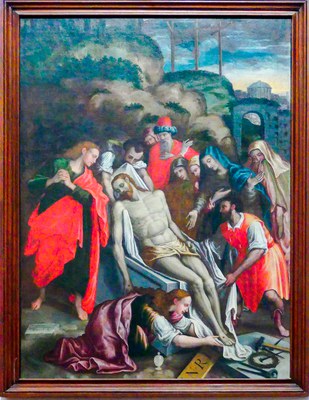Deposition
 The Deposition exibited in Polverigi is considered one of Ercole Ramazzani's best work; he was born in Arcevia and lived between 1535 and 1598. The complex and original composition on canvas, represents the Deposition of Christ between the Virgin and the pious women on the right and Saint John the Evangelist on the left, assisted by Nicodemus who helps himself with his mouth and arms to lay Jesus in the sarcophagus. Below a servant supports the legs freed from the nails while the Magdalene sprinkles the stigmata with the ointment taken from the ampoule. Above, on the top, Joseph d' Arimatea has just come from the city you can glimpse in the background of Golgotha in a leaden sunset broken by a flash of light. In this work, the iconography of the Counter-Reformation is masterfully interpreted and respected by the artist who treasures the Mannerist experiences of Zuccari, Tibaldi, Bellini, Raffaello and Michelangelo without forgetting Lotto who has had him for three years in his workshop. In the painting Ramazzani shows a complex culture and a confident and strong-willed personality that enables him to interpret the cultural situation of the time in a free and personal way and give him an unusual compositional and chromatic skill. Known for his qualities he has often been chosen as an example by other artists who were inspired by him in the following centuries such as Fabrizio Santafede in 1601 for the deposition of the Monte di Pietà in Naples.
The Deposition exibited in Polverigi is considered one of Ercole Ramazzani's best work; he was born in Arcevia and lived between 1535 and 1598. The complex and original composition on canvas, represents the Deposition of Christ between the Virgin and the pious women on the right and Saint John the Evangelist on the left, assisted by Nicodemus who helps himself with his mouth and arms to lay Jesus in the sarcophagus. Below a servant supports the legs freed from the nails while the Magdalene sprinkles the stigmata with the ointment taken from the ampoule. Above, on the top, Joseph d' Arimatea has just come from the city you can glimpse in the background of Golgotha in a leaden sunset broken by a flash of light. In this work, the iconography of the Counter-Reformation is masterfully interpreted and respected by the artist who treasures the Mannerist experiences of Zuccari, Tibaldi, Bellini, Raffaello and Michelangelo without forgetting Lotto who has had him for three years in his workshop. In the painting Ramazzani shows a complex culture and a confident and strong-willed personality that enables him to interpret the cultural situation of the time in a free and personal way and give him an unusual compositional and chromatic skill. Known for his qualities he has often been chosen as an example by other artists who were inspired by him in the following centuries such as Fabrizio Santafede in 1601 for the deposition of the Monte di Pietà in Naples.
